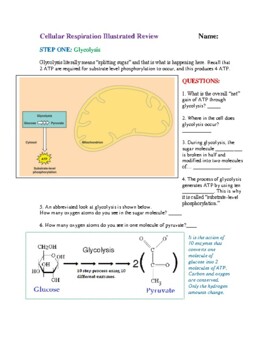Cellular Respiration Illustrated Review
Creative Curricula
186 Followers
Grade Levels
9th - 12th, Higher Education, Adult Education, Homeschool, Staff
Subjects
Resource Type
Standards
NGSSHS-LS1-5
NGSSHS-LS1-7
NGSSHS-LS1-6
NGSSHS-LS1-3
Formats Included
- PDF
Pages
4 pages
Creative Curricula
186 Followers
Description
Teaching cellular respiration to biology students can be a daunting task. This graphic review can help take the unnecessary confusion out of this complex topic. Beautifully illustrated and elegantly written, this resource neatly explains the various aspects of cellular respiration in a graphical manner that makes this highly complex sub-topic of cellular biology understandable. Students can see cellular respiration for what is actually is: a beautifully designed biochemical energy-conversion process. Ideal as a lecture/discussion supplement, an in-class cooperative learning strategy, or homework, Cellular Respiration Illustrated Review can be a valuable resource to your Advanced Biology, AP Biology, or College Biology toolkit.
Total Pages
4 pages
Answer Key
Included
Teaching Duration
45 minutes
Report this resource to TPT
Reported resources will be reviewed by our team. Report this resource to let us know if this resource violates TPT’s content guidelines.
Standards
to see state-specific standards (only available in the US).
NGSSHS-LS1-5
Use a model to illustrate how photosynthesis transforms light energy into stored chemical energy. Emphasis is on illustrating inputs and outputs of matter and the transfer and transformation of energy in photosynthesis by plants and other photosynthesizing organisms. Examples of models could include diagrams, chemical equations, and conceptual models. Assessment does not include specific biochemical steps.
NGSSHS-LS1-7
Use a model to illustrate that cellular respiration is a chemical process whereby the bonds of food molecules and oxygen molecules are broken and the bonds in new compounds are formed, resulting in a net transfer of energy. Emphasis is on the conceptual understanding of the inputs and outputs of the process of cellular respiration. Assessment should not include identification of the steps or specific processes involved in cellular respiration.
NGSSHS-LS1-6
Construct and revise an explanation based on evidence for how carbon, hydrogen, and oxygen from sugar molecules may combine with other elements to form amino acids and/or other large carbon-based molecules. Emphasis is on using evidence from models and simulations to support explanations. Assessment does not include the details of the specific chemical reactions or identification of macromolecules.
NGSSHS-LS1-3
Plan and conduct an investigation to provide evidence that feedback mechanisms maintain homeostasis. Examples of investigations could include heart rate response to exercise, stomate response to moisture and temperature, and root development in response to water levels. Assessment does not include the cellular processes involved in the feedback mechanism.





